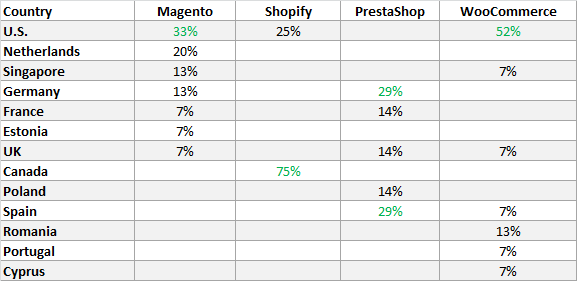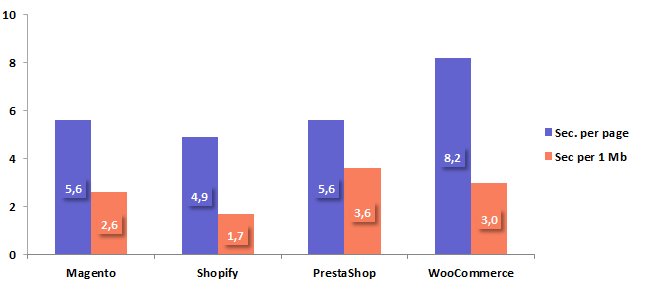
Ecommerce Platforms Comparative Speed Testing
Categorized as : Ecommerce
Magento performance is a common topic for discussions in different dedicated forums and among end users of the platform. Today we’ll try in to either confirm or debunk the myth that Magento is slower than other ecommerce platforms.

The idea behind the investigation is to compare web site speed tests of four most popular e-commerce platforms, find out the winners and their specific features.
This study compares four e-platforms that are already well-known to our readers and most online store owners: Magento, WooCommerce, Shopify, and PrestaShop. In our study we used the Pingdom Website Speed Test tool for testing desktop stores; Mobitest by Akamai for mobile testing and iplocation.net to detect web site domain IP address locations.
In general, we tested 50 random online stores from the Alexa 1 Mln Top websites list in different ways and by multiple parameters, including various test locations, different pages (e.g. main, category, and product pages), desktop and mobile web site versions, domain IP locations, and compared their loading speeds.
The results and our conclusions are presented below.
The basic finding we’ve obtained is that the average loading time of a single page is 5.9 seconds. Despite this value is too general to be used for certain purposes it shows the benchmark applicable to ecommerce stores.
Perhaps, it looks pretty slow especially if we refer to the Google recommendations for ecommerce websites asking for 2 seconds and even less. Still, that’s the real state of things. But, as far as the study includes different entrepreneurs, both successful and not, we’d like you to consider this result as the minimum acceptable level.
Still, different pages of the stores have different loading times and funnily enough all the explored platforms show the next same tendency. Main pages show the slowest seconds, while product pages run faster than any other pages. Here are the averages:
It’s is true for all the platforms…
Table 1. Average Loading Time of Pages by Platforms, sec.

… and all locations.
Table 2. Average Loading Time of Pages by Locations, sec.

Mobile pages are slightly heavier and have longer loading times on almost all platforms, except Magento and PrestaShop.
Table 3. Average Loading Time of Platforms by Devices, sec.

According to our previous studies, the mentioned above platforms have different distribution areas, e.g. Prestashop is mostly a European platform, while Shopify is especially popular in North America. This physical location often determines available hosting options and makes store better accessible from the nearest locations.
That’s why Magento and Shopify are better downloaded from the U.S., while Prestashop from Europe. Of course, we have no idea about international sales of the tested web sites, but it displays the potential opportunity to enter global markets.
Table 4. Average Loading Time of Platforms by Locations, sec.

According to the table above, Australia is going to be a great challenge for offshore stores in their competition with local sellers since all of them are slowly loaded in this country. The United States is the most frequent IP domain location in our study. Still, hosting location profiles differ greatly.
Table 5. Ecommerce Platforms Hosting Location Profiles

With only several exceptions, the closer is the location of the domain server; the faster is the loading of a web store. The average local loading time for Magento is 2.3 times better than the international one. For Shopify this ratio is 2.6, for Prestashop – 1.7, and 1.5 for WooCommerce. This way, local Magento and Shopify visitors will certainly enjoy better shopping experience, while WooCommerce shoppers will hardly notice significant difference visiting stores from different locations.
And now we are coming to the most intriguing result of our comparative study disclosing the fastest e-commerce platform. On average, Shopify is the fastest platform of our investigation 0.7 second ahead of Magento and Prestashop, while WooCommerce stays on the last position.
Diagram 1. Average Loading Time of the Studied Ecommerce Platforms

Magento takes the second position and doesn’t seem to be far behind the winner sometimes even outperforming Shopify, e.g. on mobile pages.
The average time to load 1 Mb for self-hosted platforms takes about 3 seconds. Here, Shopify has also better showings since the website hosting is provided by the platform itself and includes Content Delivery Network (CDN), which is a certainly great solution for international stores.
The study shows that Magento is good, but it can be better if we refer to global sales. The owners of international stores should closely focus on all potential markets and take into consideration the existing experience from other popular platforms.

The idea behind the investigation is to compare web site speed tests of four most popular e-commerce platforms, find out the winners and their specific features.
Study Description
This study compares four e-platforms that are already well-known to our readers and most online store owners: Magento, WooCommerce, Shopify, and PrestaShop. In our study we used the Pingdom Website Speed Test tool for testing desktop stores; Mobitest by Akamai for mobile testing and iplocation.net to detect web site domain IP address locations.
In general, we tested 50 random online stores from the Alexa 1 Mln Top websites list in different ways and by multiple parameters, including various test locations, different pages (e.g. main, category, and product pages), desktop and mobile web site versions, domain IP locations, and compared their loading speeds.
The results and our conclusions are presented below.
Speed Test Results
The basic finding we’ve obtained is that the average loading time of a single page is 5.9 seconds. Despite this value is too general to be used for certain purposes it shows the benchmark applicable to ecommerce stores.
Perhaps, it looks pretty slow especially if we refer to the Google recommendations for ecommerce websites asking for 2 seconds and even less. Still, that’s the real state of things. But, as far as the study includes different entrepreneurs, both successful and not, we’d like you to consider this result as the minimum acceptable level.
Still, different pages of the stores have different loading times and funnily enough all the explored platforms show the next same tendency. Main pages show the slowest seconds, while product pages run faster than any other pages. Here are the averages:
- Main Pages – 7.1 sec.;
- Category Pages – 5.5 sec.;
- Product Pages - 4.8 sec.
It’s is true for all the platforms…
Table 1. Average Loading Time of Pages by Platforms, sec.

… and all locations.
Table 2. Average Loading Time of Pages by Locations, sec.

Mobile pages are slightly heavier and have longer loading times on almost all platforms, except Magento and PrestaShop.
Table 3. Average Loading Time of Platforms by Devices, sec.

According to our previous studies, the mentioned above platforms have different distribution areas, e.g. Prestashop is mostly a European platform, while Shopify is especially popular in North America. This physical location often determines available hosting options and makes store better accessible from the nearest locations.
That’s why Magento and Shopify are better downloaded from the U.S., while Prestashop from Europe. Of course, we have no idea about international sales of the tested web sites, but it displays the potential opportunity to enter global markets.
Table 4. Average Loading Time of Platforms by Locations, sec.

According to the table above, Australia is going to be a great challenge for offshore stores in their competition with local sellers since all of them are slowly loaded in this country. The United States is the most frequent IP domain location in our study. Still, hosting location profiles differ greatly.
Table 5. Ecommerce Platforms Hosting Location Profiles

With only several exceptions, the closer is the location of the domain server; the faster is the loading of a web store. The average local loading time for Magento is 2.3 times better than the international one. For Shopify this ratio is 2.6, for Prestashop – 1.7, and 1.5 for WooCommerce. This way, local Magento and Shopify visitors will certainly enjoy better shopping experience, while WooCommerce shoppers will hardly notice significant difference visiting stores from different locations.
And now we are coming to the most intriguing result of our comparative study disclosing the fastest e-commerce platform. On average, Shopify is the fastest platform of our investigation 0.7 second ahead of Magento and Prestashop, while WooCommerce stays on the last position.
Diagram 1. Average Loading Time of the Studied Ecommerce Platforms

Magento takes the second position and doesn’t seem to be far behind the winner sometimes even outperforming Shopify, e.g. on mobile pages.
The average time to load 1 Mb for self-hosted platforms takes about 3 seconds. Here, Shopify has also better showings since the website hosting is provided by the platform itself and includes Content Delivery Network (CDN), which is a certainly great solution for international stores.
Key Findings
- The average website loading time of the study is 5.9 seconds (includes all platforms, testing locations, and devices);
- Product pages show the best performance on all ecommerce platforms;
- The fastest mobile pages are built on Magento and PrestaShop;
- Shopify hosts the fastest desktop pages;
- U.S. is the most optimal location for Magento and Shopify web store visitors;
- European customers will find PrestaShop-based stores most impetuous;
- Australian shoppers wait longer than other customers;
- The United States host the greatest number of explored stores;
- Shopify stores are 100% hosted in North America. PrestaShop is entirely hosted in Europe;
- Magento and Shopify stores perform comparatively better for local rather than international customers;
- Magento is the second most fastest platform of our study, Shopify is the first;
- The average time to load 1 Mb for self-hosted platforms takes about 3 seconds.
Conclusion
The study shows that Magento is good, but it can be better if we refer to global sales. The owners of international stores should closely focus on all potential markets and take into consideration the existing experience from other popular platforms.











